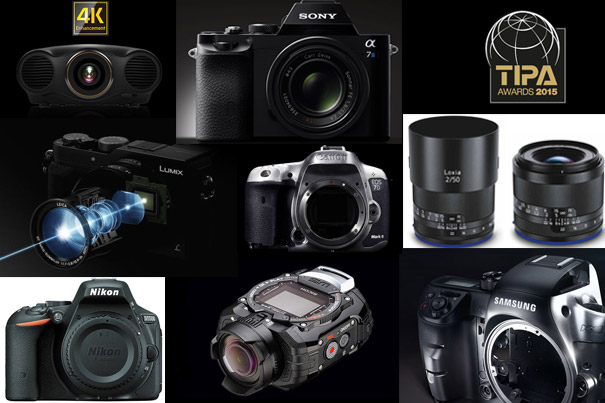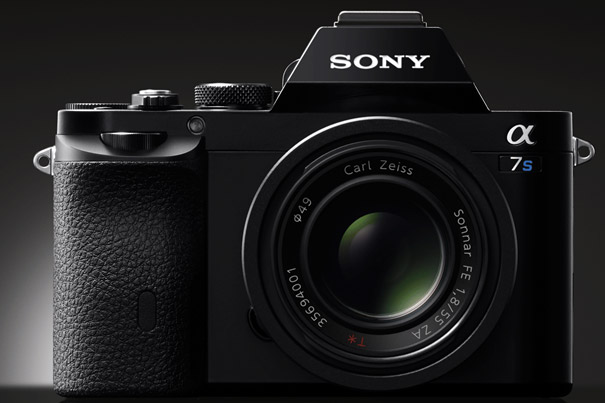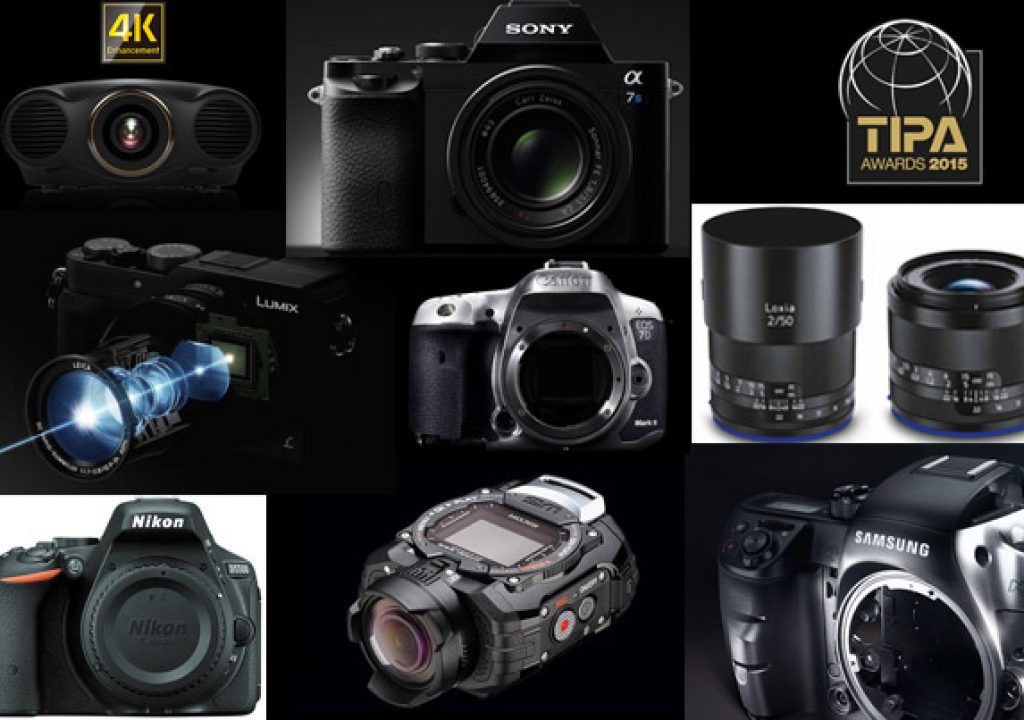
Although many of the categories in TIPA’s awards are related to photography, some of them sit on the fence between photo and video, so it makes sense to mention here at ProVideo Coalition a few of the 2015 awards.
The Technical Image Press Association (TIPA) has been giving awards for 25 years now, and even if an award is always a subjective thing, the market likes to peruse these lists and discuss their merits. After all, the votation from TIPA does represent something, as the association membership comprises 28 leading photo and imaging magazines from 15 countries on five continents, and also has a cooperative partnership with the CJPC (Camera Journal Press Club), representing 11 top photography magazines in Japan.
Most TIPA members conduct their own product testing in order to give their readers informed and first-hand product reviews. Those manufacturers who want to ensure that their new products are considered in the annual voting session are invited to send a sample directly to the TIPA magazines so that they can be evaluated and tested in detail.
A winning product should prove to be the very best in its category. TIPA editors take into account innovation, the use of leading-edge technology, design and ergonomics, ease-of-use, as well as price/performance ratio. Iot should be rememberd, thoough, that TIPA always awards the best products in each category according to its own rules and judging criteria.
The Technical Image Press Association (TIPA) member magazines recently convened for their General Assembly to vote for the best photo and imaging products launched by the industry in the last 12 months. The trophies for the 25th year of TIPA Awards will be presented to the winning companies in Tokyo, Japan on the 19th June.
Without further ado, let’s look at some of the award winners for 2015, a list chosen here at PVC based on the relation between the products receiving the awards and the video segment. We also publish the comments made by the jury regarding each winner.

Sony α7S
Sony’s strategy of using larger pixels on a full-frame Exmor CMOS sensor (12.2MP) pays dividends in a very high dynamic range (15.3 stops), excellent low-light capability (Fast Intelligent AF to -4EV and low noise) and extremely high sensitivity (extended ISO range 50-409,600). Their “direct pixel readout” utilizes the entire width of the sensor without line skipping or pixel binning, which means that both HD and 4K video data is processed from each and every one of the sensor’s pixels. The unit allows users to shoot with uncompressed 4:2:2 Full HD and uncompressed QFHD 4K video in 8-bit 4:2:2, with the latter put through to a third-party 4K recorder via HDMI. It comes equipped with SLog2 gamma, found in Sony’s professional video cameras, which offers the ability to include a picture profile for gamma, black, level and colour adjustments that can be saved for use in a multi-camera shoot.
Panasonic LUMIX DMC LX100
For enthusiasts who want both a quality still and video camera, the LX100 has a 12.8MP 4/3-inch High-Sensitivity MOS sensor, and the ability to record 4K video. The LX100 has an integral 24-75mm (equivalent) f/1.7-2.8 Leica DC Vario-Summilux lens and numerous control and exposure dials that allow for complete control over still imaging, including the ability to deliver 11 frames per second full-resolution images. The video side is quite impressive, with the ability to record Full HD 1920 x 1080 AVCHD Progressive or MP4 at 60p, or 4K 3840 x 2160 at 30 fps. Panasonic has proposed what they dub “4K Photo,” grabbing an 8MB still image from the 4K video footage. Other features include WiFi and NFC connectivity and a RAW+JPEG format choice.
Ricoh WG-M1
This hot segment of the market continues to grow and the Ricoh WG-M1 offers a unique design that is waterproof to 32 feet (9.75 metres) without an additional protective housing, is shock resistant to six feet (1.8 metres) and frost-proof to 14F (-10C). The unit has large control buttons and a 1.5-inch (3.8cm) LCD monitor. The 14 MP sensor and processor can record Full HD movies and deliver 10 frames-per-second high-speed shooting through its ultra wide-angle lens. To help users get right into action, the camera comes with a carabineer-equipped strap for carrying and a WG adhesive mount to help attach the camera to different surfaces. Optional accessories expand the camera’s usability via a wrist strap mount, helmet mount and more.
Canon EOS-7D Mark II
With specs that appeal to photographers who know what a DSLR is capable of delivering, the 20.2MP APS-C CMOS sensor in the Canon EOS 7D Mark II resides within a weather- and dust-resistant magnesium alloy body along with dual DIGIC 6 processors. The camera features 10 frames-per-second shooting rate, a 65-point (all cross type) AF system, and a 100% field of view viewfinder. Exciting features include HDR and multi-exposure modes, intervalometer and bulb timer for long exposure capture. The camera has dual card slots for both SD-type and CF cards. To support Full HD video quality there is Dual Pixel CMOS AF and dedicated stereo microphone and built-in headphone jack ports.
Nikon D5500
An entry level DSLR is one that offers easy access to all the benefits of DSLR photography to first-time users. The D5500 is a lightweight and compact DX format DSLR (APS-C) that contains a 24.2MP CMOS sensor and can deliver up to 5 frames per second at full resolution and Full HD video with a choice of four different frames per second rates, from 24p to 60p. ISO sensitivity range is between 100 and 25,600. This is the first Nikon DSLR with a Vari-angle touchscreen 3.2 inch LCD. Using Nikon’s wireless app, users can connect the camera to a compatible smartphone or tablet wirelessly with no hot spot needed. For capturing action, the top shutter speed is 1/4000 second. Numerous creative modes allow the user to personalize each image’s look and style.
Epson EH-LS10000 Projector
With almost all cameras providing Full HD video and many now with 4K as well, the EH-LS10000 Projector is a model that will match the needs of the most discriminating viewer. This projector features 4K enhancement for increased sharpness, an unprecedented Absolute Black contrast ratio, and delivers Color and White Brightness at 1500 lumens. The EH-LS10000 projector boasts a wider colour gamut, which produces richer colours and smoother gradations. The EH-LS10000 Projector offers Epson’s advanced 3LCD Reflective 3-chip technology and comes with vertical and horizontal motorized lens shift to allow for easy configuration of the projector setup.
Samsung NX1
Built for speed and responsiveness, the Samsung NX1 has a 28.2MP APS-C CMOS sensor and the company’s DRIMe V processor that drives both 4K video and a full-resolution still image shooting rate of 15 frames per second, all with AF. Viewing is via a 3-inch 1036-K-dot AMOLED tilting touch-screen monitor as well as a high resolution 2360K-dot XGA OLED EVF. The camera has an ISO range of 100-25,600 (Ext. 51,200) and a new hybrid AF system that combines phase-and contrast-detection with AF points that cover almost the entire viewfinder screen. There are a host of video options that the NX1 supports DCI 4K – 4096 x 2160 at 24P and UHD 4K – 3840 x 2160 at 24P/30P. Also, NX1 can capture up to 120fps at Full HD. Connectivity is via WiFi, NFC and Bluetooth, as well as USB 3.0. A free Samsung Camera Manager app aids in transferring images and for remote control operation.
Zeiss Loxia Line
Designed for those whose passion is engagement in the picture-making process, ZEISS Loxia lens are manual focus and aperture setting lenses made specifically for Sony e-mount full-frame cameras. There are two current lenses in the line-up, both with a maximum aperture of f/2—a 35mm and a 50mm. The 35mm lens is based on a Biogon design and is constructed with nine elements in six groups and has a minimum focusing distance of 0.3 metres (slightly less than a foot). The 50mm is based on a Planar design and has six elements in four groups, with a similar close-focusing distance of 0.37 metres (1.2 feet). A “declickable” aperture setting (free range) can be used for video shooting. A large focus rotation angle of 180-degees allows for very precise focusing.


